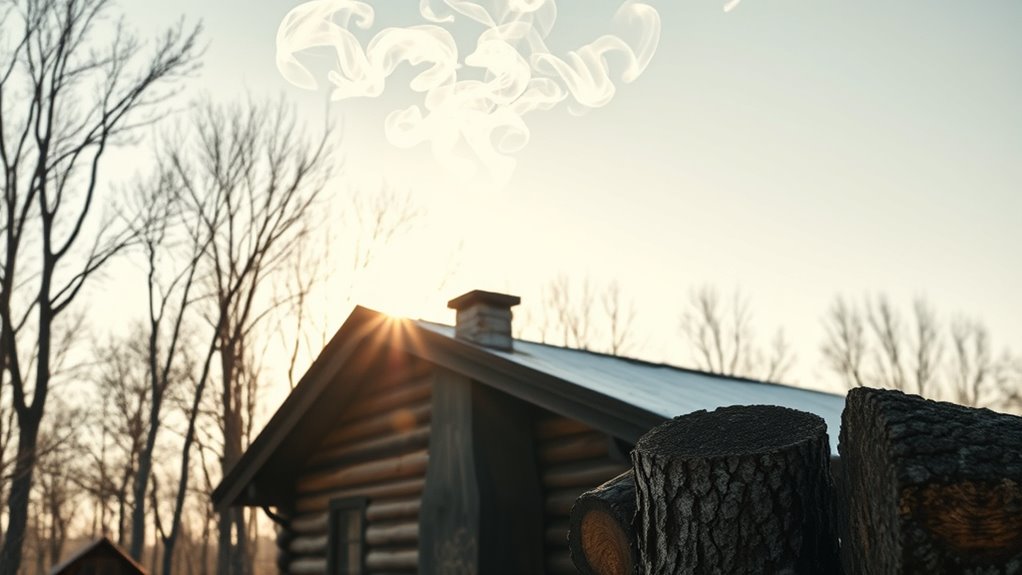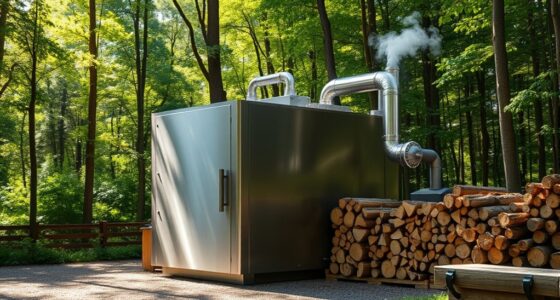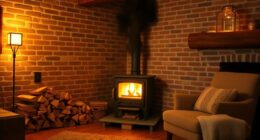Many believe that burning wood indoors is safe if you have good ventilation, but this isn’t true—wood smoke still releases harmful particles that can cause respiratory and heart problems. Using dry or seasoned wood doesn’t eliminate danger either; pollutants are released during combustion regardless. Small or occasional fires can still harm indoor air quality, especially without proper ventilation. To stay healthier, it’s crucial to understand these facts and explore proven strategies to reduce your exposure. If you keep learning, you’ll find ways to protect yourself better.
Key Takeaways
- Burning wood always produces harmful indoor pollution, but proper ventilation and dry wood can reduce health risks.
- Well-ventilated indoor wood burning is safe if combined with air filtration and good combustion practices.
- Using seasoned, dry wood significantly reduces smoke emissions, but does not eliminate all pollutants.
- Occasional or small-scale wood burning still impacts indoor air quality, especially without adequate ventilation.
- Myths suggest that wood smoke is harmless or only affects outdoor air; in reality, it can cause serious indoor health issues.

Have you ever wondered if wood smoke is really as harmful as some claim? It’s a common concern, especially for those who use fireplaces or wood stoves regularly. The truth is, wood smoke does contribute to indoor pollution, which can have serious health impacts if not managed properly. When you burn wood indoors, tiny particles and chemicals are released into the air you breathe. These pollutants can penetrate deep into your lungs and even enter your bloodstream, leading to a variety of health problems. The key is understanding the extent of these impacts and how to minimize them, rather than dismissing wood smoke altogether.
Many people believe that burning wood in a well-ventilated space is harmless, but that isn’t entirely accurate. Indoor pollution from wood smoke can still pose risks, especially if ventilation isn’t adequate. Fine particulate matter from wood smoke, often called PM2.5, is particularly dangerous because it’s small enough to evade your body’s natural defenses. Prolonged exposure to these particles has been linked to respiratory issues, such as asthma and bronchitis, and has also been associated with cardiovascular problems. Even short-term exposure can cause irritation of your eyes, nose, and throat. So, while burning wood can create a cozy atmosphere, it’s important to recognize the potential health impacts that come with indoor smoke.
A common myth is that using seasoned or dry wood completely eliminates health risks. While dry wood burns cleaner and produces less smoke, it doesn’t eliminate all pollutants. The combustion process still releases harmful particles and chemicals into your indoor environment. Hence, relying solely on dry wood isn’t enough to make indoor burning completely safe. Proper ventilation, air filtration, and burning techniques are vital to reduce indoor pollution and protect your health. It’s not just about the type of wood you burn, but also about how you burn it and how well your space is ventilated. Additionally, understanding the importance of indoor pollution control can help you implement effective strategies for safer indoor air quality. Implementing ventilation methods such as exhaust fans or air purifiers can significantly reduce the concentration of harmful particles indoors.
People also assume that small-scale or occasional wood burning doesn’t considerably impact health. But even infrequent use can contribute to indoor pollution if your space isn’t properly ventilated. Over time, these small exposures can add up, especially for vulnerable populations like children, the elderly, or those with pre-existing health conditions. It’s essential to be aware of the potential health impacts and take steps to limit your exposure. This could mean installing air purifiers, ensuring good airflow, or choosing alternative heating methods when possible. Recognizing the realities of indoor pollution from wood smoke helps you make informed decisions to protect your health without giving up the comfort of a wood fire. Additionally, understanding the role of indoor pollution in health risks emphasizes the importance of proper ventilation and pollution control measures. Being aware of indoor pollution sources enables better management of indoor air quality and health outcomes.
Frequently Asked Questions
Can Wood Smoke Ever Be Completely Safe to Breathe?
Wood smoke can never be completely safe to breathe because it negatively impacts air quality and has serious health implications. Even small exposures can cause respiratory issues, allergies, and other health problems over time. To protect yourself, minimize exposure by burning properly, using well-seasoned wood, and ensuring good ventilation. Staying informed about air quality alerts helps you avoid harmful smoke and reduces your risk of health complications.
How Does Wood Type Affect Smoke Emissions and Health Risks?
A chain is only as strong as its weakest link, and that applies to wood smoke too. Different wood species release varying levels of harmful emissions, with hardwoods generally burning cleaner than softwoods. Combustion efficiency also plays a role—efficient burning reduces smoke and health risks. So, choosing the right wood and ensuring proper combustion can markedly lower health hazards from smoke emissions.
Are There Environmental Benefits to Using Wood for Heating?
Using wood for heating offers environmental benefits like supporting renewable energy sources and contributing to carbon neutrality when managed sustainably. By choosing responsibly harvested wood, you help reduce reliance on fossil fuels, lowering greenhouse gas emissions. Additionally, wood is a renewable resource that, when burned efficiently, releases fewer pollutants. This sustainable approach can help balance energy needs with environmental preservation, making wood a more eco-friendly heating option.
What Are the Best Practices to Reduce Indoor Wood Smoke Exposure?
To reduce indoor wood smoke exposure, you should improve indoor air quality by ensuring proper ventilation strategies. Always use your stove or fireplace with a well-maintained chimney, and keep vents open to allow fresh air in. Avoid indoor burning when possible, and install air purifiers with HEPA filters. Regularly clean your stove and chimney to prevent smoke buildup, and consider using certified, dry wood to produce less smoke.
How Does Wood Smoke Impact Local Air Quality During Winter?
During winter, wood smoke worsens local air quality by increasing particulate matter in the air. When you burn wood, tiny particles are released, which can linger and degrade air quality around your home and community. This pollution can cause health problems, especially for children, the elderly, and those with respiratory issues. To protect your environment, use cleaner burning techniques and guarantee proper ventilation to reduce particulate matter emissions.
Conclusion
Don’t let myths obscure the truth about wood smoke. As you’ve seen, understanding the facts helps you make safer, more informed choices. Remember, knowledge is the flame that dispels darkness—illuminating the path to healthier living. By separating myth from fact, you can enjoy the warmth and ambiance of wood smoke while minimizing health risks. Let this clarity be your guiding light, turning misconceptions into stepping stones toward a more informed and mindful approach.











